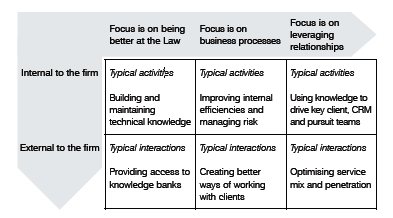Home » BLOG » Business Development » Leading the Edge
Leading the Edge
Published in KMLegal magazine
A key component of building the bridge between theory and realisation in the utilisation of knowledge assets lies in improvements in a broad range of leadership capabilities within the KM function itself, according to Andrew Hedley.
If law firms are to be effective in building a competitive advantage through knowledge management (KM) they need to invest in both their infrastructure capabilities and the influencing skills of their knowledge leaders and advocates.
The impact of KM leadership has two dimensions:
- Creating a better understanding of how a firm can create competitive advantage through adopting a leading position. This will be achieved by managing current knowledge assets more effectively and investing in the innovation and creation of new knowledge capital;
- A wider recognition of the importance of personal leadership skills by senior KM professionals, accompanied by ongoing investment in developing these capabilities. These will be at the heart of delivering ultimate success.
Taking the first of these dimensions, what are the potential benefits to a firm adopting a strategy based on clientoriented KM leadership?
My contention is that a law firm has two fundamental business constructs that it needs to optimise – knowledge and relationships.
Without wishing to cast the net so wide as to be disingenuous, if knowledge and relationships are considered in the fullest sense of these words, they encompass all that is important about the profession and its future vitality.
Knowledge and relationships
The word ‘knowledge’ should rightly embrace the legal-technical knowledge that provides accurate answers to clients’ questions and enables the efficient operation of the production machine that is the lawyer-base of the firm. However, we must broaden our thinking and the application of techniques more widely to encompass client, competitor, intermediary, relationship and market knowledge, if we are to inform the overall development of the business.
The intersect of knowledge and relationships is also clear: by unlocking the wisdom and insight embedded in client and contact relationships, the firm is able to surface a raft of new opportunities. The result will be increased revenues from current service lines and the broadening of the client franchise into new areas.
As Ross Dawson illustrates in his excellent treatise, Developing Knowledge-Based Client Relationships: Leadership in Professional Services, the effective use of knowledge assets is at the core of creating profitable client relationships, which deliver high-value and at the same time create a “vibrant and sustainable business model”. He makes the important point that “in this world, the only way to lock in clients is by consistently being able to create more value for them than your competitors can. This is a positive form of lock-in, in contrast to the negative lock-in of trying to make it expensive for clients to leave you.”
Of course, an added dimension of such an approach in an environment in which the war for talent is as much a business-critical issue as the war for clients, is that effective KM techniques become an important factor in attracting the best people. We live in a world where a significant percentage, if not the majority, of new recruits have an eye as much on ‘what the firm can do for me’ as ‘what I can do for the firm’. The existence of advanced systems that enable them to acquire this learning will be an added attraction. The challenge for the firm, of course, is retention and ensuring that key knowledge assets and intellectual properties are embedded in systems and processes.
An important question that needs to be considered is that, if KM does provide firms with a competitive edge, what sort of leadership skills are needed to ensure this advantage is maintained?
It is a truism that those building a career in KM, just like all other professionals, need to demonstrate high technical skills in their core subject materials to gain promotion up the first few rungs of their management ladder. Also in common with other professionals, as seniority increases the range of competencies that need to be developed broadens. Technical excellence becomes what business development strategists term a ‘hygiene factor’ – it is necessary but not sufficient. Other capabilities will be needed to advance further, ranging from hard management competencies, such as budgetary control and project management, to softer skills centred on motivation, performance management and negotiation.
At the pinnacle of the development pyramid for KM leaders is the ability to envision the future, to articulate this in a series of compelling messages and to lead their team and influence their firm to achieve these objectives.
Emotional intelligence
However, in the same way that technical ability (as a knowledge manager) should not be taken as an indicator of managerial competency, management skills do not necessarily endow one with great leadership acumen. While leadership and management responsibilities will often be bundled together in the same job specification, the smart person will disaggregate these components as quickly as possible, as they require very different abilities to deliver the success that the firm seeks.
John Kotter of Harvard Business School hits the nail on the head when highlighting the important difference between the two. He argues that, at its most fundamental, management is about dealing with complexity. A good manager can analyse a situation, breaking it down into its component parts, understanding the inter-relationship between each one and reassembling them in a way that improves efficiency and effectiveness.
Leadership, however, is about dealing with change. It is about having a clear vision and the personal skills to persuade others to come with you on the journey.
KM is a fast-developing field. Those who hesitate run the risk of being left behind while other firms capitalise on new ways of serving clients, improving internal efficiencies and developing added-value services, which will build the firm’s brand. But a risk is perceived in investing in KM, especially when the investment is in technology that has a limited track record or which will result in significant implementation challenges.

Figure 1: The flight path for knowledge leadership
To overcome these hurdles, there are three leadership skills that need to be developed:
- Leading and empowering a team of direct reports. Imbuing in them a sense of purpose and a commitment to working together to deliver the sorts of results that the firm needs;
- Influencing a management board that may be sceptical to the promised benefits and under pressure from other areas to allocate the available budget elsewhere;
- Engaging broadly and selling the vision of the difference that KM can make to the wider community of lawyers and business-support professionals across the firm and within the client base.
While each of these requires a different mix of abilities, they have in common a requirement for high levels of emotional intelligence. Since first being postulated by Daniel Goleman, the concept of emotional intelligence has become accepted as a key factor in the success of managers and leaders. This is particularly true in the sort of people-centric business epitomised by law firms. Goleman has written widely, but his seminal piece on the impact of emotional intelligence on leadership is contained in a Harvard Business Review article published in the November/ December 1998 edition, and entitled ‘What makes a Leader?’ His salient conclusion is that: “It would be foolish to assert that good old-fashioned IQ and technical ability are not important ingredients in strong leadership. But the recipe would not be complete without emotional intelligence. It was once thought that the components of emotional intelligence were nice to have in business leaders. But we now know that, for the sake of performance, these are ingredients that leaders need to have.”
Most importantly, Goleman makes it clear that emotional intelligence can be developed. This is something that would benefit many in management roles within the KM profession. Given the wide array of audiences that need to be influenced and led if KM is to succeed, it is clear that the abilities of those with well-developed emotional intelligence to “find common ground with people of all kinds – a knack for building rapport” will be particularly well-suited to these organisational challenges.
In summary, there is a compelling argument that effective utilisation and exploitation of knowledge assets will provide a source of sustainable competitive advantage, if firms are able to cross the chasm that divides theory and vision from implementation and realisation. A key component of building the bridge lies in improvements in a broad range of leadership capabilities within the KM function itself.
It is increasingly self-evident that there is a clear edge that can be gained through KM in an increasingly undifferentiated market, where peer-group firms look increasingly similar in almost every respect. Those that can bring the full range of leadership dimensions to bear will find themselves with a difficult-to-replicate competitive advantage.
This article was published in September 2008 by the KMLegal magazine. To read the original article click here.
Search
Categories
Recent Posts
- Fighting fit
- The Challenges Of Leadership Are Different To The Challenges Of Management
- The Cultural Dimensions Of Leveraging Institutional Knowledge
- A knowledge-led approach to business development is key to law firm resilience
- Team Morale Is Directly Linked To The Ability To Deliver Differentiated Client Services
